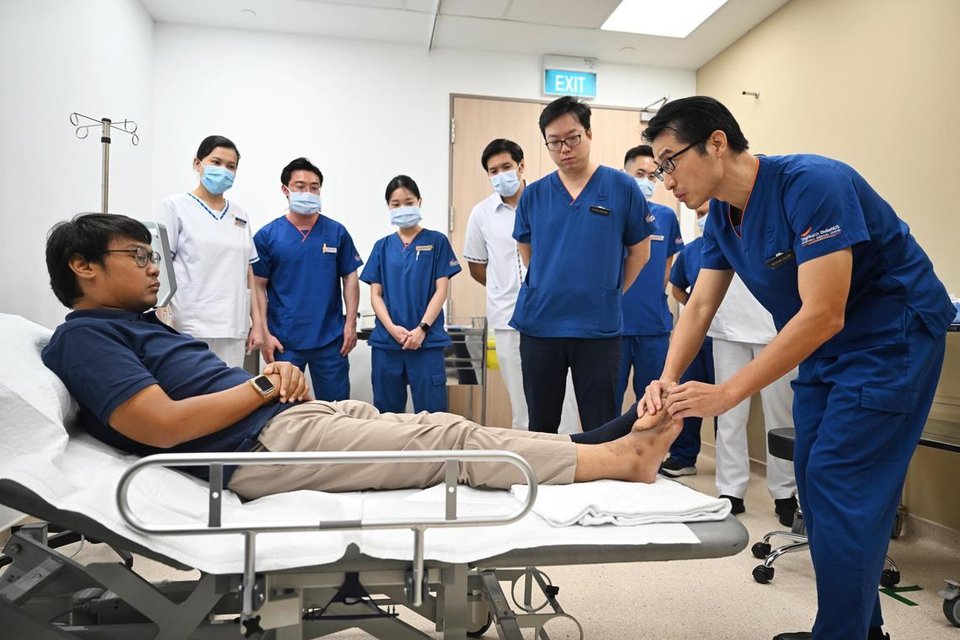Another $25m for research to fight eye disease that affects up to one in 10 seniors

Published on
16 Sep 2024
Published by
The Straits Times
SINGAPORE – Madam Sng Soh Gek, 76, had a shock in early August 2023 when she realised that there was a dim, blurry spot in the vision of her right eye.
She was worried that she would suffer a fate similar to that of a relative who has lost complete vision in his right eye because of age-related macular degeneration (AMD).
It turned out that she had good reason to be concerned and to see a doctor about it.
Madam Sng was diagnosed with AMD early and has been receiving treatment since August 2023 as part of a clinical study that involves a team from the Singapore Eye Research Institute (Seri).
The institute announced on Sept 2 that it had secured an additional $25 million research grant from the National Medical Research Council (NMRC) for the Translational Asian Age-related Macular Degeneration Programme.
The programme started in 2018 with a $24 million research grant from NMRC.
Led by Professor Gemmy Cheung, head of the Singapore National Eye Centre’s (SNEC) medical retina department, Seri’s research team aims to reduce the number of people suffering vision loss due to the disease by 20 per cent over the next 10 years.
AMD is a chronic irreversible condition that often results in vision loss in the centre of the visual field because of damage to the macula – the central part of the retina. The condition can make it difficult for patients to read, recognise faces or drive safely. It is one of the leading causes of blindness affecting those 50 years or older, in Singapore and worldwide.
About 5 per cent to 7 per cent of people aged 40 and above in Singapore have this disease in varying degrees of severity. For those aged 70 and above, AMD can affect up to one in every 10 people.
By 2040, AMD is projected to affect 288 million people across the world, of which 113 million are in Asia.
Seri’s AMD programme concluded its first phase at the end of July. During this phase of their research, the team discovered new genes linked to AMD.
Prof Cheung said the research team will study how these genes affect the body’s metabolism and how other factors, including environmental ones, contribute to the development of AMD.
The team is working with the Agency for Science, Technology and Research (A*Star) on developing an antibody that can block a chemical substance which is elevated in individuals with AMD.
The new injection of funds for the programme will go towards the work in the second phase, which will focus on the development of earlier detection methods and better treatments.
There are four key areas in phase two of the programme – personalised treatment strategies, identification of high-risk individuals, development of better diagnostic tools and the study of the new genes linked to the development of AMD.
Working together with Seri and SNEC in the second phase are A*Star, Nanyang Technological University, National University of Singapore Yong Loo Lin School of Medicine, Duke-NUS Medical School, Singapore General Hospital and National University Hospital.
AMD patients typically receive eye injections to treat the condition. Patients can expect about six to nine such injections in the first year of treatment, followed by three to four every year thereafter.
Prof Cheung said the team is developing new treatments that last longer and can cater to patients with varying degrees of severity of AMD.
The team also hopes to focus on early detection and preventive intervention in high-risk individuals in the community.
Prof Cheung said risk factors include smoking or having a family history of AMD. But these explain only a small proportion of cases.
While there is no cure for AMD, early diagnosis and treatment can help preserve more vision by preventing permanent tissue damage.
Seri is teaming up with SingHealth to screen patients for AMD in community hospitals from early 2025. They hope to find 300 people with early AMD and monitor them for symptoms of advanced AMD over three to five years.
Other than a dim, blurry spot in one’s vision, symptoms also include crooked vision (straight lines appearing wavy) or patchy loss of vision.
A common complication that can occur in the later stages of AMD is fibrosis – the formation of scar tissue in the eye. It occurs in an estimated 50 per cent of patients with AMD.
Madam Sng, who works as a sales promoter, has received six intravitreal injections since August 2023 and is scheduled for another in November. She said the injections were painless and that the blurry spot she used to see is now gone.
“This disease is no joke. If you detect any blurry spot in your vision, it is best to get it checked as early as possible. Now I am fine and I can see things clearly,” she added.
Prof Cheung noted that there is a lack of public awareness about the disease in many Asian countries, including Singapore, although there has been progress in recent years.
“Distortion and patchy vision may be early symptoms. Delaying until there is severe blurring can lead to worse outcomes even with treatment,” she added.
SNEC is organising an upcoming webinar on Oct 12 for the public to learn more about AMD.
For more information, visit str.sg/rEmQ
Source: The Straits Times © SPH Media Limited. Reproduced with permission.
ALL views, content, information and/or materials expressed / presented by any third party apart from Council For Third Age, belong strictly to such third party. Any such third party views, content, information and/or materials provided herein are for convenience and/or general information purposes only. Council For Third Age shall not be responsible nor liable for any injury, loss or damage whatsoever arising directly or indirectly howsoever in connection with or as a result of any person accessing or acting on any such views, content, information and/or materials. Such third party views, content, information and/or materials do not imply and shall not be construed as a representation, warranty, endorsement and/or verification by Council For Third Age in respect of such views, content, information and/or materials.







